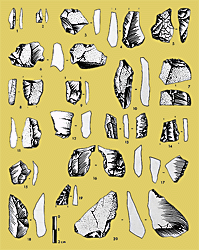

Franchthi Cave was used during the Upper Palaeolithic
The abundance of animal bones from bisons, chamois and wild ass as well as a small amount of fish, marine shells and plant remains, suggests that hunting was a primary means of finding food for the cave inhabitants whereas fishing and food-gathering were less important.
The tool industry includes backed blades and triangular or trapezoid microliths. The microliths served as inserts in wooden or bone shafts to make points or knives.
The human presence in the cave has been confirmed by separate skeletal finds some of which belong to children.